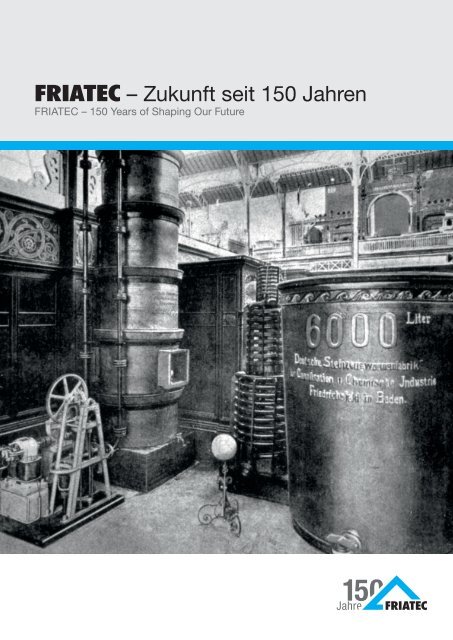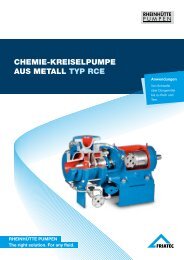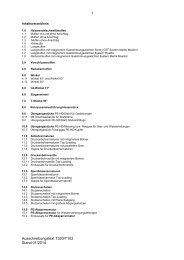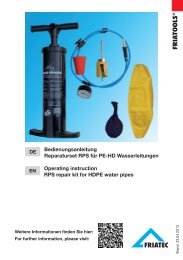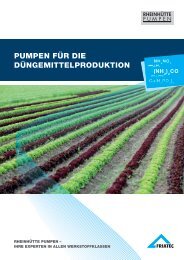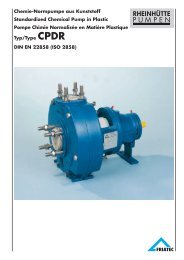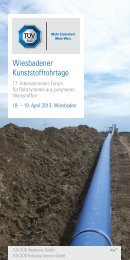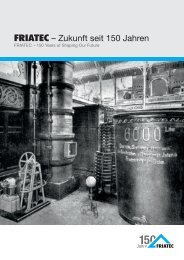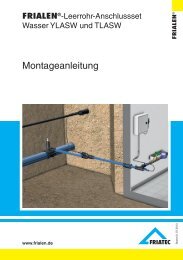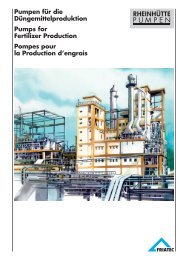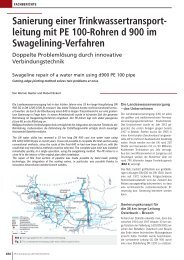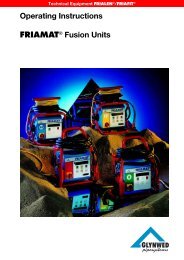FRIATEC – Zukunft seit 150 Jahren - Friatec AG
FRIATEC – Zukunft seit 150 Jahren - Friatec AG
FRIATEC – Zukunft seit 150 Jahren - Friatec AG
Sie wollen auch ein ePaper? Erhöhen Sie die Reichweite Ihrer Titel.
YUMPU macht aus Druck-PDFs automatisch weboptimierte ePaper, die Google liebt.
<strong>FRIATEC</strong> <strong>–</strong> <strong>Zukunft</strong> <strong>seit</strong> <strong>150</strong> <strong>Jahren</strong><br />
<strong>FRIATEC</strong> <strong>–</strong> <strong>150</strong> Years of Shaping Our Future
Logo im Wandel<br />
Evolution of the Logo<br />
1895 1925 1930<br />
Das Titelbild zeigt das erste in der Welt hergestellte, aus<br />
einem Stück bestehende Steinzeuggefäß von 6000 Liter<br />
Inhalt für die Weltausstellung in Paris um 1900.<br />
The cover displays the world’s first stoneware container<br />
made from a single piece. It had a capacity of 6,000 litres<br />
and was produced specifically for the 1900 Paris World Exhibition.
1968 1984 1993 2001
Die Entstehung der Steinzeugfabrik<br />
Die Anfänge<br />
Beginn der unternehmerischen Tätigkeiten Otto Reinhards<br />
als Ziegler und Kalkbrenner in Mannheim. Die Gründung der<br />
Reinhard’schen Ziegelei ist höchstwahrscheinlich für das<br />
Jahr 1863 anzunehmen.<br />
Was bedeutet Reinhard für die Geschichte der späteren<br />
Steinzeugfabrik?<br />
Er ist zwar nicht der direkte Ahnherr des Werkes, jedoch<br />
derjenige, der durch seine Ziegelei das spätere Werksgelände<br />
der industriellen Nutzung zugeführt hat.<br />
Bilddokumente aus dieser Zeit existieren nicht.<br />
Firmennamen-Entwicklung:<br />
1863 Reinhard’sche Ziegelwaarenfabrik<br />
Die ununterbrochene Firmengeschichte der heutigen FRIA-<br />
TEC <strong>AG</strong> begann im Sommer 1873.<br />
Julius Friedrich Espenschied eröffnet auf dem Reinhardschen<br />
Ziegeleigelände bei Friedrichsfeld eine Filiale seiner<br />
Zementfabrik.<br />
Espenschieds Fabrik in Mannheim floriert, er beschäftigt<br />
<strong>150</strong> Arbeiter.<br />
Von dem erfolgreichen Unternehmer und großem Pferdeliebhaber<br />
ist überliefert, dass er zu Pferd oder mit einer<br />
vierspännigen Kutsche in die Fabrik zu kommen pflegte.<br />
Die erste Erwähnung von Tonröhren im Zusammenhang mit<br />
Friedrichsfeld in einem Inserat innerhalb der Heidelberger<br />
Zeitung ist vom Juni 1874 bekannt.<br />
Firmennamen-Entwicklung:<br />
1873 Filiale der Mannheimer Portland-Cementfabrik<br />
1863 1873<br />
The Origin<br />
Otto Reinhard starts his entrepreneurial activities as<br />
brick maker and lime burner in Mannheim. It is very<br />
likely that the foundation of Reinhard‘sche Ziegelei took<br />
place around 1863.<br />
So what is his part in the history of the future stone<br />
works?<br />
Even though he is not the direct founding father of the<br />
plant, he is nevertheless the one to pave the way for the<br />
industrial operations to take place on the later premises.<br />
Visual documentary material of the early years of the<br />
brick works is not available.<br />
Evolution of the company name:<br />
1863 Reinhard‘sche Ziegelwaarenfabrik<br />
The Beginnings of the Stone Works<br />
The uninterrupted corporate history of today’s <strong>FRIATEC</strong><br />
<strong>AG</strong> started in the summer of 1873.<br />
Julius Friedrich Espenschied opens a subsidiary of his<br />
cement plant on the premises of Reinhard‘sche Ziegelei<br />
close to the Mannheim suburb of Friedrichsfeld.<br />
Espenschied’s Mannheim works flourishes; he employs<br />
<strong>150</strong> workers.<br />
The successful entrepreneur and great horse enthusiast<br />
is said to have always come to his works either on horseback<br />
or in a carriage drawn by four horses.<br />
Earthenware pipes in connection with Friedrichsfeld<br />
were first mentioned in an advertisement published in<br />
Heidelberger Zeitung in June 1874.<br />
Evolution of the company name:<br />
1873 Subsidiary of Mannheimer Portland-Cementfabrik<br />
4 <strong>150</strong> Jahre <strong>FRIATEC</strong> / <strong>150</strong> years of <strong>Friatec</strong>
Die Badische Thonröhren <strong>AG</strong><br />
Älteste Abbildung<br />
der „Steinzeug-(Thon) Waaren-Fabrik“ auf einer Preisliste.<br />
Die1880er Jahre sind geprägt durch eine starke Expansion<br />
der Tonröhren- und Steinzeugproduktion, einhergehend mit<br />
einemständigen Zuzug auswärtiger Töpfer.<br />
Gegen Ende der achtziger Jahre erforderte das rasche<br />
Wachstum jährlich beachtliche Investitionen. Man war zu<br />
einer Kapitalaufstockung gezwungen und beschloss die<br />
Umwandlung der Einzelfirma in eine Aktiengesellschaft. Am<br />
12. Juli 1890 wird die „Badische Thonröhren- & Steinzeugwaarenfabrik,<br />
vormals J.F. Espenschied, Aktiengesellschaft“<br />
gegründet.<br />
Trotz langer Arbeitszeit bei hoher körperlicher Belastung<br />
entwickelte sich in diesen <strong>Jahren</strong> eine Firmentreue der Belegschaft<br />
zu „ihrer Fabrik“. Die Identifikation der Arbeiter<br />
mit der Firma drückte sich zum Beispiel in der Gründung<br />
eines „Männergesangvereins Frohsinn“ aus.<br />
Das Bild oben zeigt den Männergesangverein Frohsinn,<br />
1886 und zum Vergleich unten ein Bild aus den 1970er<br />
<strong>Jahren</strong>.<br />
Firmennamen-Entwicklung:<br />
1876 J.F. Espenschied Portland-Cementfabrik<br />
Friedrichsfeld<br />
Firmennamen-Entwicklung:<br />
1886 J.F. Espenschied Cement- und Thonwaarenfabrik<br />
Friedrichsfeld<br />
1878 J.F. Espenschied Portland-Cement- und<br />
Thonwaarenfabrik Friedrichsfeld<br />
1890 Badische Thonröhren- und Steinzeugwaarenfabrik<br />
<strong>AG</strong>, vormals J.F. Espenschied<br />
1880 1890<br />
Oldest Image<br />
of “Steinzeug-(Thon) Waaren-Fabrik” on a price list. The<br />
1880s are marked by a massive expansion of the production<br />
of earthenware pipes and stoneware articles in<br />
parallel with a constant influx of non-resident potters.<br />
Evolution of the company name:<br />
1876 J.F. Espenschied Portland-Cementfabrik Friedrichsfeld<br />
1878 J.F. Espenschied Portland-Cement- und Thonwaarenfabrik<br />
Friedrichsfeld<br />
Badische Thonröhren <strong>AG</strong><br />
Towards the end of the 1880s, the company’s rapid<br />
growth called for substantial annual investments. The<br />
company had to increase its capital stock and was transformed<br />
from a sole proprietorship into a stock corporation.<br />
“Badische Thonröhren- & Steinzeugwaarenfabrik,<br />
vormals J.F. Espenschied, Aktiengesellschaft” is established<br />
on 12 July 1890. Despite long working hours and<br />
high physical stress the workforce developed a corporate<br />
loyalty to “their works” in those years. For example, the<br />
workers’ identification with the company was reflected<br />
by the establishment of the “Frohsinn” (gaiety) male chorus<br />
at that time. The top picture depicts the Frohsinn male<br />
chorus, 1886,the photo at the bottom shows the male<br />
chorus in the 1970s.<br />
Evolution of the company name:<br />
1886 J.F. Espenschied Cement- und Thonwaarenfabrik<br />
Friedrichsfeld<br />
1890 Badische Thonröhren- und Steinzeugwaarenfabrik<br />
<strong>AG</strong>, vormals J.F. Espenschied<br />
<strong>150</strong> Jahre <strong>FRIATEC</strong> / <strong>150</strong> years of <strong>Friatec</strong><br />
5
Sichtbare Expansion und Modernisierung<br />
Gesamtaufnahme vor Errichtung des Verwaltungsgebäudes<br />
um 1895.<br />
Aus derselben Perspektive nach Errichtung des Verwaltungsgebäudes<br />
1899.<br />
Inzwischen hat die Fabrik neun Schornsteine.<br />
Firmennamen-Entwicklung:<br />
1894 Deutsche Steinzeugwaarenfabrik für Canalisation<br />
und Chemische Industrie<br />
1895 Deutsche Steinzeugwaarenfabrik für Canalisation<br />
und Chemische Industrie Friedrichsfeld Baden, später<br />
Deutsche Steinzeugwarenfabrik für Kanalisation und<br />
Chemische Industrie Friedrichsfeld<br />
Weltweite Aner kennung des Werkes<br />
Die Fabrikation von Transportflaschen und großen Gefäßen<br />
zum Aufbewahren säurehaltiger Flüssigkeiten<br />
wurde bis zur höchsten Vollkommenheit entwickelt. Das<br />
Bild zeigt das erste in der Welt hergestellte, aus einem<br />
Stück bestehende Steinzeuggefäß von 6000 Liter Inhalt<br />
für die Weltausstellung in Paris um 1900.<br />
Titel<strong>seit</strong>e der Sondernummer der Zeitschrift „Deutsche<br />
Industrie <strong>–</strong> Deutsche Kultur“, VII, die im September 1909<br />
der Deutschen Steinzeugwarenfabrik gewidmet war.<br />
1899 1909<br />
Visible Expansion and Modernisation<br />
Long shot prior to the construction of the administrative<br />
building, around 1895.<br />
From the same perspective after construction of the administrative<br />
building, 1899.<br />
New chimneys were erected on the premises in the<br />
meantime.<br />
Evolution of the company name:<br />
1894 Deutsche Steinzeugwaarenfabrik für Canalisation<br />
und Chemische Industrie<br />
Worldwide Recognition of the Company<br />
The production of shipping bottles and large containers<br />
to store acidic liquids was developed to the point of perfection.<br />
The photo displays the world’s first stoneware<br />
container made from a single piece. It had a capacity of<br />
6,000 litres and was produced specifically for the 1900<br />
Paris World Exhibition.<br />
Front page of the special issue of “Deutsche Industrie <strong>–</strong><br />
Deutsche Kultur”, VII, dedicated to Deutsche Steinzeugwarenfabrik<br />
in September 1909.<br />
1895 Deutsche Steinzeugwaarenfabrik für Canalisation<br />
und Chemische Industrie Friedrichsfeld Baden, and later<br />
Deutsche Steinzeugwarenfabrik für Kanalisation und<br />
Chemische Industrie Friedrichsfeld i.B.<br />
6 <strong>150</strong> Jahre <strong>FRIATEC</strong> / <strong>150</strong> years of <strong>Friatec</strong>
Der große Streik von 1912<br />
Die Arbeiterbewegung in Deutschland begann Ende des<br />
19. Jahrhunderts sich in Gewerkschaften zu organisieren.<br />
1912 kam es zum großen Streik. Absicht war, für<br />
bessere Arbeitsbedingungen zu kämpfen und soziale<br />
Polaritäten abzubauen. Die harte Auseinandersetzung<br />
wurde durch ein großes Presseecho begleitet. Der Streik<br />
begann am 2. Juni und wurde erst Ende Juli nach erfolgreichen<br />
Verhandlungen beendet.<br />
Die Fotos zeigen die soziale Polarität in dieser Zeit: Die<br />
Angestellten im technischen Büro, 1909, und ungelernte<br />
Arbeiter, typische Vertreter des Proletariats, 1897.<br />
Die Zeit des I. Weltkrieges<br />
Infolge der geringer werdenden Bautätigkeit sank der<br />
Bedarf an Kanalisationsartikeln ständig. Viele gelernte<br />
Töpfer wurden zum Militärdienst eingezogen, sodass<br />
die Produktivität stetig sank. Die Produktion wurde auf<br />
den Kriegsbedarf umgestellt, vor allem im Bereich des<br />
chemischen Steinzeugs. Von 840 Mitarbeitern im Jahre<br />
1914 sank die Belegschaft im Jahre 1916 auf 590 ab<br />
und stieg dann bei Kriegsende wieder auf 757 an.<br />
Die Fotos zeigen eine Feldpostkarte vom 25. September<br />
1915 an einen eingezogenen Töpfer mit Hinweisen auf<br />
die Arbeitslage.<br />
1912 1914-1918<br />
The Great Strike of 1912<br />
The workers’ movement began to establish trade unions<br />
in Germany in the late 19th century. It led to the<br />
great strike of 1912 in which workers fought for better<br />
working conditions and the abolition of social polarities.<br />
The fierce clash of ideas attracted considerable press<br />
coverage. The strike began on 2 June and lasted until<br />
the end of July, when negotiations could be concluded<br />
successfully.<br />
The photos reflect the social polarities at that time:<br />
employees in the Technical Office, 1909, and unskilled<br />
workers, typical representatives of the proletariat, 1897.<br />
The Great War Period<br />
Due to decreasing construction activities, the demand<br />
for sewage products receded. Many trained potters<br />
were drafted, leading to a constant reduction of productivity.<br />
The production was switched to meet the demand<br />
for war equipment, in particular in the area of chemical<br />
stoneware. The company’s number of workers went<br />
down from 840 in 1914 to 590 in 1916 to recover to<br />
757 at the end of the war.<br />
The photos show a field postcard from 25 September<br />
1915, sent to a drafted potter and informing him of the<br />
current workload.<br />
<strong>150</strong> Jahre <strong>FRIATEC</strong> / <strong>150</strong> years of <strong>Friatec</strong><br />
7
Der Absatz im In- und Ausland<br />
In dieser Periode der Firmengeschichte wurde durch die politischen und wirtschaftlichen<br />
Katastrophen die Möglichkeit zu exportieren mehrmals auf null reduziert. Trotz<br />
dieser negativen Ausgangslage gelang es ab der zweiten Hälfte der zwanziger Jahre<br />
durch Innovationen neue Absatzmärkte zu gewinnen. Chemisches Steinzeug wurde<br />
weltweit immer stärker nachgefragt.<br />
Beginnende Entwicklung von der<br />
Handarbeit zur Automation<br />
Die Umstellung von der Walzenpresse auf die Schneckenpresse<br />
in der Röhrenproduktion, die 1924 abgeschlossen<br />
war, ermöglichte eine kurze Arbeitszeit und den Wegfall<br />
mehrerer Schichten. Töpferarbeit bleibt jedoch noch lange<br />
Handarbeit wie das Bild aus den 30er <strong>Jahren</strong> zeigt.<br />
1924 1930<br />
The Shift from Manufacturing to Automation<br />
The changeover in the tube production from roller pressing<br />
to screw pressing which was completed in 1924<br />
allowed for shorter working hours and the cancellation<br />
of various work shifts. However, making earthenware<br />
products remained manual work for a long time, as may<br />
be gathered from the photo taken in the 1930s.<br />
National and International Sales<br />
In that period of the corporate history the company’s opportunities to export its products<br />
were foiled various times due to political and economic catastrophes.<br />
Despite that negative initial setting, the company <strong>–</strong> thanks to its innovative products<br />
<strong>–</strong> succeeded in tapping new sales markets as from the second half of the 1920s. The<br />
demand for chemical stoneware increased more and more all over the globe.<br />
8 <strong>150</strong> Jahre <strong>FRIATEC</strong> / <strong>150</strong> years of <strong>Friatec</strong>
Die Jahre des Wiederaufbaus<br />
Die Zeit des II. Weltkrieges<br />
Im Zweiten Weltkrieg wiederholte sich vieles, was wir<br />
schon vom Ersten Weltkrieg her kennen. Aus Furcht vor<br />
Luftangriffen wurden wichtige Teile der Fertigung in nicht<br />
luftkriegsbedrohte Fertigungsstätten verlagert. Aufgrund<br />
des Instanzenwirrwarrs im NS-Deutschland war dies<br />
ein mehr als mühseliges Unterfangen. Zu Zerstörungen<br />
von Werksanlagen kam es allerdings erst in den letzten<br />
Kriegstagen.<br />
Um das Jahr 1950 war das Wort Wiederaufbau ganz<br />
wörtlich zu nehmen im Sinne von Wiederherstellung der<br />
alten Strukturen und der traditionellen Produktion. So<br />
waren 1951/52 die drei letzten kriegszerstörten Fabrikgebäude<br />
wieder errichtet mit einer verbesserten Tonaufbereitungsanlage<br />
und einem neuen Greiferdrehkran.<br />
1954 hatte die deutsche Steinzeugindustrie ihre Vorkriegsproduktion<br />
erreicht. Durch den damaligen Bauboom<br />
entstand eine stark ansteigende Nachfrage. Um<br />
in dieser Situation die Steinzeugröhrenproduktion zu<br />
rationalisieren und zu beschleunigen, wurden 1956 die<br />
Tunnelöfen „Max & Moritz“ errichtet, die zwei von den<br />
neun Fabrikschornsteinen überflüssig machten.<br />
1939-1945 1950<br />
The World War II Period<br />
The World War II period saw the repetition of many things<br />
the company had already experienced during the Great<br />
War. For fear of air raids, important production equipment<br />
was relocated to sites which were not considered<br />
susceptible to air attacks. Due to the tangle of institutional<br />
competencies typical of Nazi Germany that proved to be<br />
an arduous task. However, production equipment was<br />
not destroyed until the final days of the war.<br />
The Years of Reconstruction<br />
Around the year 1950, the term ‘reconstruction’ was to<br />
be taken literally in the sense of ‘restoration of former<br />
structures and traditional production’. Hence, the last<br />
three production buildings destroyed during the war<br />
were restored in 1951/52, now holding an improved clay<br />
treatment system and a new claw-type revolving crane.<br />
In 1954, the German stoneware industry had again reached<br />
its pre-World War II production level. As the result<br />
of the building boom at that time, demand increased<br />
strongly. To rationalise and accelerate its stoneware<br />
pipe output in that situation the company installed the<br />
tunnel kilns “Max & Moritz” in 1956, rendering redundant<br />
two of the new chimneys on the premises.<br />
<strong>150</strong> Jahre <strong>FRIATEC</strong> / <strong>150</strong> years of <strong>Friatec</strong><br />
9
<strong>FRIATEC</strong> wird 100 Jahre<br />
Seit 1961 beschäftigte sich die Firma mit der Herstellung von<br />
Produkten aus Aluminiumoxid und der Entwicklung neuer<br />
keramischer Werkstoffe, wobei sich das Werk zunehmend<br />
auf die Beratung und Hilfe durch das Cremer-Forschungsinstitut<br />
(CFI) in Rödental stützen konnte, das 1963 vor<br />
allem auf die Initiative vom Aufsichtsrat hin eingerichtet<br />
worden war.<br />
Hieraus entwickelte sich der erfolgreiche Bereich der Oxidkeramik.<br />
Dieser Bereich stellt heute ein eigenes Werk dar,<br />
mit großzügigen Gebäuden und Fertigungsanlagen in denen<br />
die FRIALIT- und DEGUSSIT-Fertigung konzentriert ist.<br />
Firmennamen-Entwicklung:<br />
1961 Deutsche Steinzeug- und Kunststoffwarenfabrik<br />
für Kanalisation und Chemische Industrie Mannheim-<br />
Friedrichsfeld<br />
Beginn des Ökologie-Zeitalters<br />
Zu Beginn der 1960er Jahre begann die Öffentlichkeit, die Ökologie<br />
zu entdecken. Qualmende Schornsteine waren jahrzehntelang<br />
ein Zeichen für Wachstum und Wohlstand, nun erregten<br />
sie Anstoß. Deswegen hatte man <strong>seit</strong> 1960 begonnen, die Produktion<br />
umweltfreundlicher zu gestalten. Zunächst sparte man<br />
durch Optimierungen im Brennvorgang monatlich 1.500 Tonnen<br />
Kohle. Kohlebefeuerte Hochleistungsöfen wurden nach und nach<br />
auf Ölbefeuerung umgestellt. Seit Anfang 1967 experimentierte<br />
man auch mit Gasbefeuerung, mit dem Ziel den Rußausstoß<br />
völlig zu be<strong>seit</strong>igen.<br />
Im Herbst 1971 konnte man zum rauch- und rußfreien Betrieb<br />
übergehen. Die nun überflüssigen Schornsteine konnten bis auf<br />
einen abgetragen werden.<br />
1963 1967<br />
<strong>FRIATEC</strong>´S 100 th Anniversary<br />
The company has focused on aluminium oxide products<br />
and the development of novel ceramic materials since<br />
1961. Moreover, it intensifies its cooperation with the<br />
research institute Cremer-Forschungsinstitut (CFI) in<br />
Rödental, offering consultancy and assistance services.<br />
CFI was established in 1963 particularly at the instigation<br />
of the Supervisory Board.<br />
From that emerged the successful oxide ceramics unit.<br />
Today, this division forms a company of its own, operating<br />
in vast buildings and production halls pooling the<br />
FRIALIT and DEGUSSIT activities.<br />
Evolution of the company name:<br />
1961 Deutsche Steinzeug- und Kunststoffwarenfabrik<br />
für Kanalisation und Chemische Industrie Mannheim-<br />
Friedrichsfeld<br />
The Dawn of the Ecolocical Era<br />
In the early 1960s, people became aware of the aspects<br />
of ecology. For decades, smoking chimneys were regarded<br />
as an indicator of growth and prosperity. Now,<br />
they gave cause for offence. Hence, the company started<br />
rendering its production processes more environmentally<br />
friendly as early as 1960. First, the company<br />
succeeded in saving 1,500 tons of coal each month<br />
by optimising its firing processes. Gradually, coal-fired<br />
heavy-duty kilns were converted to oil-firing. In early<br />
1967, the company also conducted experiments on<br />
gas-firing, aiming at completely eliminating carbon particulate<br />
emission.<br />
In the autumn of 1971, the company took up its smokeand<br />
soot-free production processes. The now redundant<br />
chimneys were <strong>–</strong> except for one <strong>–</strong> dismantled.<br />
10 <strong>150</strong> Jahre <strong>FRIATEC</strong> / <strong>150</strong> years of <strong>Friatec</strong>
Übernahme der Firma Rhein-Plastik-Rohr<br />
Im Produktportfolio der übernommenen Rhein-Plastik-Rohr aus Mannheim-Neckarau entfielen<br />
je etwa 5% des Umsatzes auf drei unscheinbare Unternehmensbereiche: Rohrpostrohr,<br />
Teppichrohr und Elektroschweißfittings. Die Weiterentwicklung der Elektroschweißfittings<br />
zu den heutigen FRIALEN-Sicherheitsfittings wurde zu einer Erfolgsgeschichte. Der Bereich<br />
führte 1985 zur Gründung der Division Technische Kunststoffe, welcher bis heute zu einer<br />
tragenden Säule der Firma geworden ist.<br />
Firmennamen-Entwicklung:<br />
1972 Friedrichsfeld GmbH Steinzeug- und Kunststoffwerke<br />
Die neuen Werkstoffe<br />
Das letzte Steinzeugrohr verlässt den Ofen am 20. Okt<br />
1982, das Ende einer über 100 Jahre alten Tradition in<br />
Friedrichsfeld.<br />
Die Herstellung von Kanalisationsröhren aus PVC, eigentlich<br />
eine Substitution des Steinzeugs in seinem klassischen Bereich,<br />
konnte nicht unterbleiben angesichts der wachsenden<br />
Bedeutung dieses Kunststoffs.<br />
<strong>Zukunft</strong>strächtig war auch die Entwicklung von großflächigen<br />
Labortischplatten.<br />
1979 1982<br />
Takeover of Rhein-Plastik-Rohr<br />
The product portfolio of the Mannheim, Neckarau-based company Rhein-Plastik-Rohr<br />
held three nondescript business units, each accounting for some 5 per cent of its total<br />
sales volume: pneumatic tubes, carpet tubes and electrofusion fittings. Development<br />
work on the electrofusion fittings leading to the FRIALEN safety fittings has turned into<br />
a success story. This unit led to the establishment of the Technical Plastics Division in<br />
1985 which is up to this very day one of the supporting pillars of the company.<br />
Evolution of the company name:<br />
1972 Friedrichsfeld GmbH Steinzeug- und Kunststoffwerke<br />
New Materials<br />
The last stoneware pipe leaves the kiln on 20 October<br />
1982, marking the end of a tradition looking back on<br />
more than one hundred years in Friedrichsfeld.<br />
In view of the ever-increasing importance of PVC, the<br />
production of sewage pipes made of this material<br />
<strong>–</strong> actually replacing stoneware in its classic areas <strong>–</strong><br />
proved to be inevitable.<br />
The development of extended laboratory bench tops turned<br />
out to be a forward-looking approach as well.<br />
<strong>150</strong> Jahre <strong>FRIATEC</strong> / <strong>150</strong> years of <strong>Friatec</strong><br />
11
Der Turn around<br />
Da die Firma aufgrund ihres Alters und der gewachsenen Kostenstrukturen keine guten<br />
Voraussetzungen für homogene Massenprodukte mehr hatte, schlug man den Weg zur<br />
qualitativ hochwertigen Spezialisierung ein.<br />
Der Weg der Umstrukturierung und des Neuaufbaus war 1987 beendet mit dem besten<br />
Betriebsergebnis der Nachkriegszeit.<br />
In der Presse war zu lesen: „Keramik hat das Steinzeug verdrängt. Völlig neues Gesicht der<br />
Friedrichsfeld GmbH in Mannheim“ oder „Reform an Haupt und Gliedern. Friedrichsfeld hat<br />
Organisation und Sortiment erfolgreich gestrafft.“<br />
Abriß und Neubau <strong>seit</strong> 1984<br />
Firmennamen-Entwicklung:<br />
1985 Friedrichsfeld GmbH Keramik- und Kunststoffwerke<br />
Der Sturz des traditionsreichen Wasser- und Uhrturms und<br />
der Abriss großer Teile der alten Bahnfront sind symbolisch<br />
für die völlige Neustrukturierung des Werks.<br />
1984 1987<br />
Demolition and Reconstruction Since 1984<br />
The fall of the water and clock tower with its longstanding<br />
tradition and the demolition of major sections<br />
of the former railway front symbolise the complete<br />
restructuring of the plant.<br />
The Turnaround<br />
As the company <strong>–</strong> due to its age and cost structures which evolved over a long time<br />
<strong>–</strong> did no longer meet the requirements for homogenous mass products, the Management<br />
decided to take the path of high-quality specialisation.<br />
The road to reorganisation and reconstruction was finished in 1987, recording the<br />
company’s best post-war operating result.<br />
The press wrote: ”… ceramic materials have substituted stoneware …”, “… the completely<br />
new face of Friedrichsfeld GmbH in Mannheim …“, or “… root-and-branch<br />
reform. Friedrichsfeld has successfully streamlined its organisation and product lines<br />
…”.<br />
Evolution of the company name:<br />
1985 Friedrichsfeld GmbH Keramik- und Kunststoffwerke<br />
12 <strong>150</strong> Jahre <strong>FRIATEC</strong> / <strong>150</strong> years of <strong>Friatec</strong>
Internationale Präsenz<br />
1988 bot sich die Gelegenheit die RHEINHÜTTE in Wiesbaden<br />
zu übernehmen. Die RHEINHÜTTE brachte ein Netz<br />
von Auslandstöchtern ein, in denen FRIEDRICHSFELD noch<br />
nicht vertreten war. Im Hinblick auf Europa war so ein wichtiges<br />
Ziel erreicht, in möglichst vielen Märkten mit einer<br />
schlagkräftigen Organisation vertreten zu sein. Überdies<br />
war das Produktprogramm der RHEINHÜTTE eine glückliche<br />
Ergänzung des eigenen Programms. Weitere neue Vertriebsbüros<br />
entstanden Anfang der 1990er Jahre.<br />
Börsengang der <strong>FRIATEC</strong> <strong>AG</strong><br />
Die Firma öffnet sich dem Kapitalmarkt und geht mit 4 Mio<br />
Stammaktien à nominal 5 DM an die Börse. Die voll ins<br />
Unternehmen fließenden Mittel sollen für den Ausbau der<br />
bestehenden Geschäftsaktivitäten, vor allem im Ausland,<br />
verwendet werden.<br />
Firmennamen-Entwicklung:<br />
1993 <strong>FRIATEC</strong> <strong>AG</strong> Keramik- und Kunststoffwerke<br />
1988 1995<br />
International Presence<br />
In 1988, the company seized the opportunity to acquire<br />
RHEINHÜTTE, located in Wiesbaden near Frankfurt.<br />
RHEINHÜTTE incorporated a wide network of subsidiaries<br />
in countries in which FRIEDRICHSFELD had not yet<br />
been present. With a view to Europe, the company thus<br />
attained one of its major aims: being present with an<br />
efficient organisation in as many markets as possible.<br />
Moreover, the product portfolio of RHEINHÜTTE proved<br />
to be a fortunate addition to the company’s own product<br />
lines. Further new sales representations were set up in<br />
the early 1990s.<br />
<strong>FRIATEC</strong> <strong>AG</strong> Goes Public<br />
The company enters the capital market, offering to the<br />
public 4 million ordinary shares at a nominal price of<br />
DM 5 each. The proceeds to be fully invested in the<br />
company should be used to expand <strong>FRIATEC</strong>’s current<br />
business activities in particular abroad.<br />
Evolution of the company name:<br />
1993 <strong>FRIATEC</strong> <strong>AG</strong> Keramik- und Kunststoffwerke<br />
<strong>150</strong> Jahre <strong>FRIATEC</strong> / <strong>150</strong> years of <strong>Friatec</strong><br />
13
Vollständige Übernahme der Vereinigte<br />
Kunststoff-Pumpen GmbH, Rennerod<br />
Nach einer <strong>seit</strong> 1978 bestehenden Beteiligung wird die<br />
RHEINHÜTTE durch den Erwerb aller noch ausstehenden<br />
Gesellschaftsanteile zum Alleingesellschafter der VKP.<br />
Firmennamen-Entwicklung:<br />
1997 <strong>FRIATEC</strong> Aktiengesellschaft<br />
<strong>FRIATEC</strong> <strong>AG</strong> <strong>–</strong> Der Wandel symbolisch<br />
Die Reihenfolge der Firmenembleme bis zum heute aktuellen<br />
Logo.<br />
1998 2001<br />
Complete takeover of Vereinigte Kunststoff-<br />
Pumpen GmbH, Rennerod, Germany (VKP)<br />
Based on an interest acquired in 1978, RHEINHÜTTE<br />
purchases all outstanding VKP shares to become its sole<br />
shareholder.<br />
<strong>FRIATEC</strong> <strong>AG</strong> <strong>–</strong> Evolution of the Logo<br />
The company’s logos in chronological order up to the<br />
one currently used.<br />
Evolution of the company name:<br />
1997 <strong>FRIATEC</strong> Aktiengesellschaft<br />
14 <strong>150</strong> Jahre <strong>FRIATEC</strong> / <strong>150</strong> years of <strong>Friatec</strong>
<strong>FRIATEC</strong> feiert einen „runden“ Geburtstag<br />
<strong>FRIATEC</strong> <strong>AG</strong> - ein Unternehmen der Aliaxis-Gruppe<br />
<strong>FRIATEC</strong> wird zu einem Unternehmen der Aliaxis-Firmengruppe<br />
und profitiert <strong>seit</strong>dem von der Integration in einen<br />
starken, weltweit agierenden Konzern mit mehr als 100<br />
Firmen, verteilt auf über 40 Länder. ALIAXIS ist der weltgrößte<br />
Hersteller von Kunststoff-Rohrleitungssystemen für<br />
das Bauwesen, die Industrie und Versorgungsunternehmen.<br />
und blickt auf <strong>150</strong> Jahre Firmengeschichte zurück. Um diese<br />
lange Zeitspanne zu verdeutlichen, hier vier Ereignisse aus<br />
dem Gründungsjahr:<br />
QQ<br />
das Fußballspiel wird erfunden; die englische FA wird<br />
als erster Fußballverband der Welt gegründet<br />
QQ<br />
Jules Verne veröffentlicht seinen ersten Roman „Cinq<br />
semaines en ballon“<br />
QQ<br />
Abraham Lincoln ist Präsident der USA; das Land<br />
befindet sich mitten im Amerikanischen Bürgerkrieg;<br />
QQ<br />
Die erste U-Bahn der Welt, die Metropolitan Line, wird<br />
in London eröffnet<br />
2003 2013<br />
<strong>FRIATEC</strong> <strong>AG</strong> <strong>–</strong> An ALIAXIS Group Member Company<br />
<strong>FRIATEC</strong> joins the Aliaxis group of companies to benefit<br />
from its integration in a strong combine operating on<br />
international scale, composed of over 100 firms and<br />
spanning over more than 40 countries worldwide.<br />
ALIAXIS is the worldwide largest producer of plastic<br />
pipe systems for the construction sector, the industry<br />
and utilities.<br />
<strong>FRIATEC</strong> celebrates its Milestone Anniversary<br />
to look back on <strong>150</strong> years of corporate history. To help you<br />
visualise this long time span let us bring back to your<br />
mind just four events which took place in the year of<br />
its foundation:<br />
QQ<br />
QQ<br />
QQ<br />
QQ<br />
The game of football is invented and the world<br />
sees the foundation of the first football association:<br />
the English FA<br />
Jules Verne publishes his first novel entitled “Five<br />
Weeks in a Balloon”<br />
Abraham Lincoln is President of the USA<br />
The world’s first underground line <strong>–</strong> the<br />
Metropolitan Line <strong>–</strong> is inaugurated in London, UK<br />
<strong>150</strong> Jahre <strong>FRIATEC</strong> / <strong>150</strong> years of <strong>Friatec</strong><br />
15
<strong>FRIATEC</strong> Aktiengesellschaft<br />
Steinzeugstraße 50<br />
68229 Mannheim<br />
Phone: +49 621 486-0<br />
Fax: +49 621 486-1279<br />
info@friatec.de<br />
www.friatec.de


